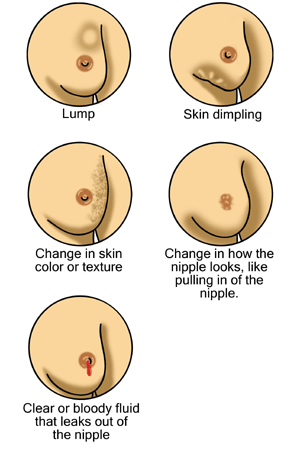Frequently Asked Questions Breast Awareness and Breast Self-Exam
Home > Frequently Asked Questions > Breast Self-Exam
 [Printer-friendly version -- PDF file, 120 Kb] [Printer-friendly version -- PDF file, 120 Kb]
See also . . .
Why should I do a breast self-exam?
Women should know how their breasts normally look and feel. Doing regular breast self-exams is the best way to know this. They also help you to notice any changes in your breasts. This is also true for women who have breast implants. A change can be a sign of a problem. If you find a change, see your doctor right away.
Most breast changes or lumps are not cancer. But only a doctor can tell for sure. When breast cancer is found early, you have more treatment choices and a better chance of recovery. So, it is best to find breast cancer as early as possible.
Breast self-exams should not take the place of regular screening mammograms or clinical breast exams, which are done by a doctor. Screening mammograms and clinical breast exams can help doctors find breast cancer early. Treatment is more likely to work well when cancer is found early.
Women ages 20 to 39 should have a clinical breast exam at least once every 3 years. Once a woman turns 40, she should have a clinical breast exam each year and a screening mammogram every 1 to 2 years. Ask your doctor how often you need one. Breast self-exams are an option for women starting in their 20s. Ask your doctor about the benefits and limitations of breast self-exam.
What am I looking for when I do a breast self-exam?
You are looking for:
- a hard lump or knot in or near the breast or in your underarm
- a change in the way your breasts look or feel
If you find a lump or other change in one of your breasts, check out the other breast. If both breasts feel the same, the lumpiness is probably normal. Get to know your breasts better by doing breast self-exams. This will help you to tell the difference between how your breasts normally look and feel and any changes. Here are some other changes to look out for:
- dimpling, puckering, or ridges of the skin on the breast
- a nipple that is pushed inward rather than sticking out
- redness, warmth, swelling, or pain
- itchy, scaly sore or rash on the nipple
- nipple discharge other than breast milk
- change in color, shape, size, or texture of a breast
If you see or feel any of these changes, see your doctor right away.

Is there a right way to examine my breasts?
Yes. There are several “right ways” to examine your breasts. Ask your doctor to teach you how to do a breast self-exam. You need to make sure you are doing it correctly.
The American Cancer Society also has a guide that shows the right way to examine your breasts. Visit its web site at:
http://www.cancer.org/docroot/CRI/content/CRI_2_6x_How_to_perform_a_breast_self_exam_5.asp?sitearea=.
Breast Health Access for Women with Disabilities has a guide for breast self-exam for women who have physical limitations. Visits its web site at:
http://www.bhawd.org/sitefiles/bse/bse_broc.html.
Be sure to discuss any new lump or change with your doctor.
How often should I do a self-exam?
Doing a regular breast self-exam is optional. It’s okay to not do a breast self-exam or to not do it on a fixed schedule. But doing a breast self-exam regularly is a good way to get to know how your breasts normally look and feel. This way, you can more easily notice changes. The best time to do a breast self-exam is when your breasts are not tender or swollen, such as a few days after your period ends.
For more information...
For more information on breast cancer screening, call womenshealth.gov at 800-994-9662 or contact the following organizations:
National Cancer Institute's Cancer Information Service
Phone: (800) 422–6237 or (800) 4-CANCER
Internet Address: http://www.nci.nih.gov/
American Cancer Society
Phone: (800) 227–2345 or (800) ACS-2345
Internet Address: http://www.cancer.org/
National Breast and Cervical Cancer Early Detection Program
Phone number: (800)–232–4636 or (800) CDC–INFO
Internet address: http://www.cdc.gov/cancer/nbccedp/index.htm
National "Get A Mammogram: Do It For Yourself, Do It For Your Family" Campaign
(brochures in English, Chinese, Tagalog, and Vietnamese)
National Cancer Institute (NCI)
Phone Number(s): (800) 422–6237 or (800) 4–CANCER
Internet Address: http://breasthealth.cancer.gov
Content last updated September 28, 2008.
|
![]() You may need to download a free PDF reader to view files marked with this icon.
You may need to download a free PDF reader to view files marked with this icon.